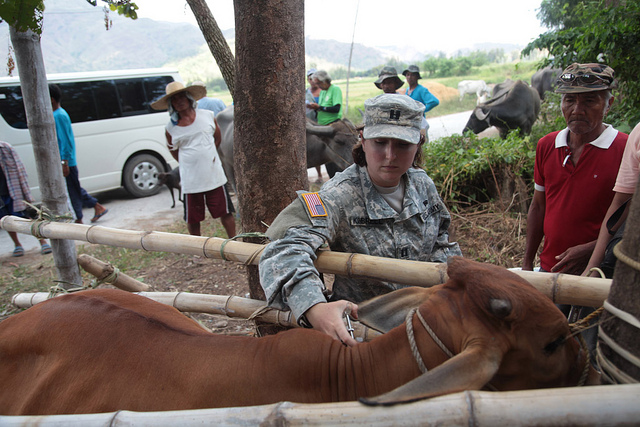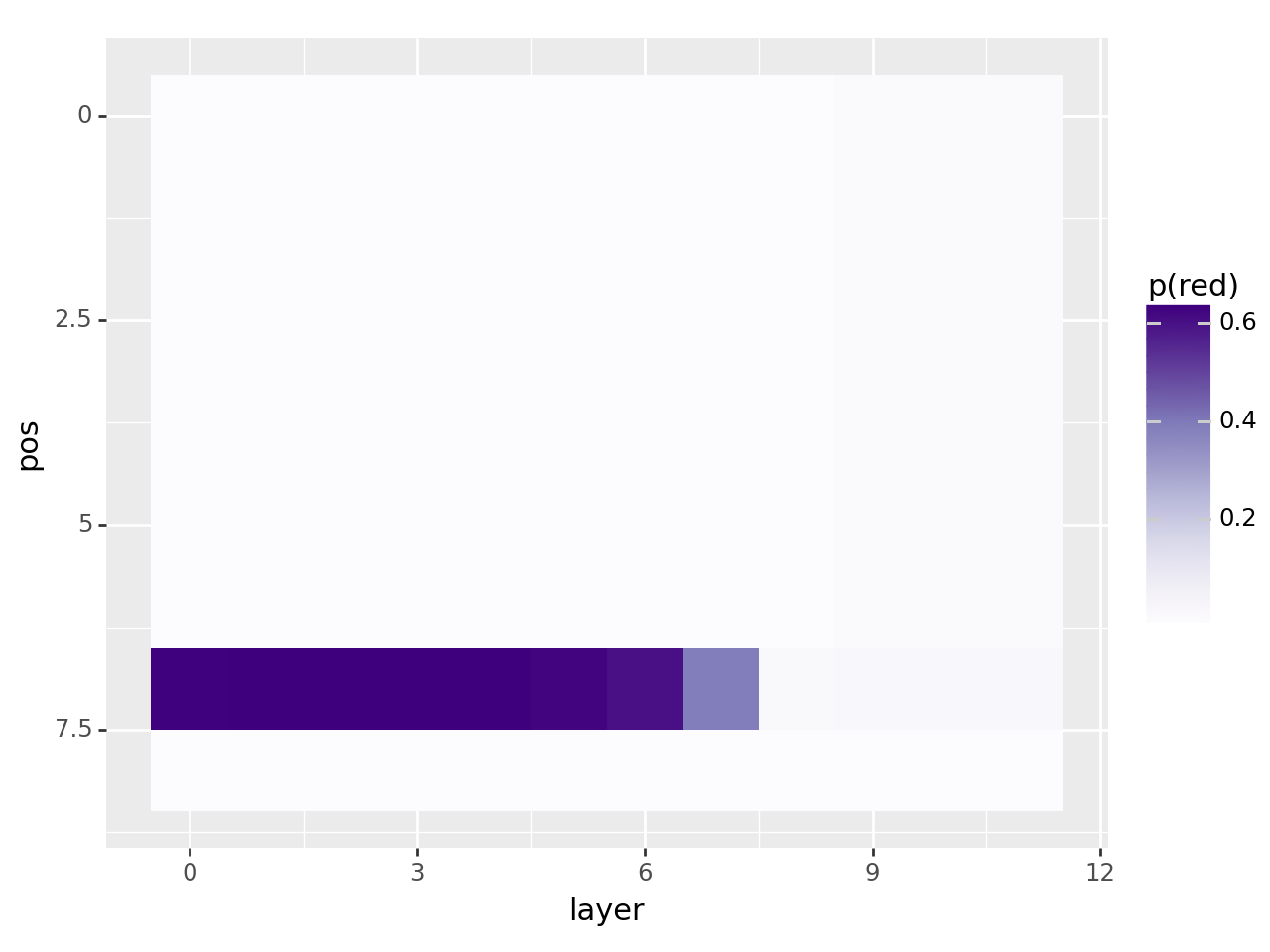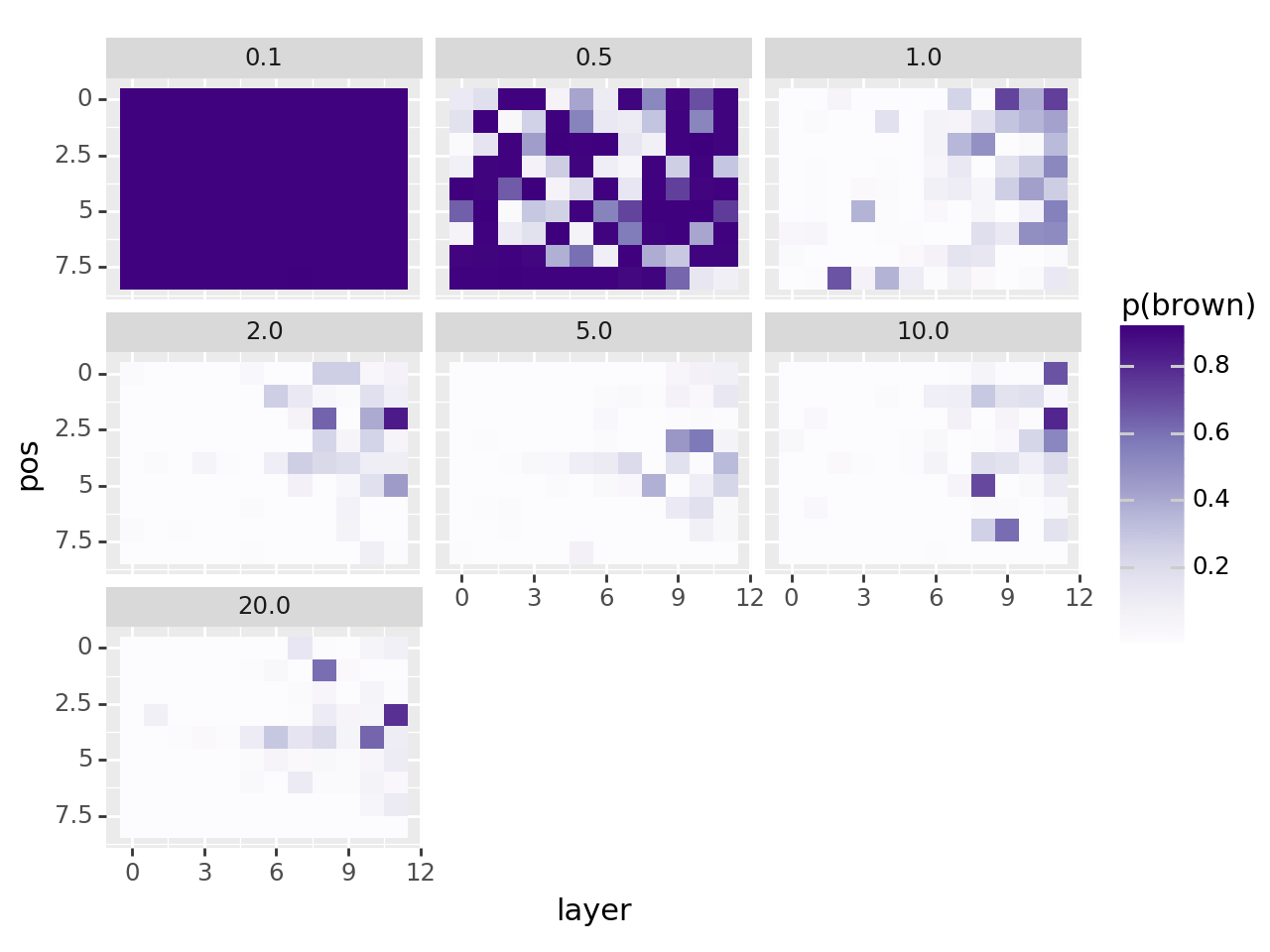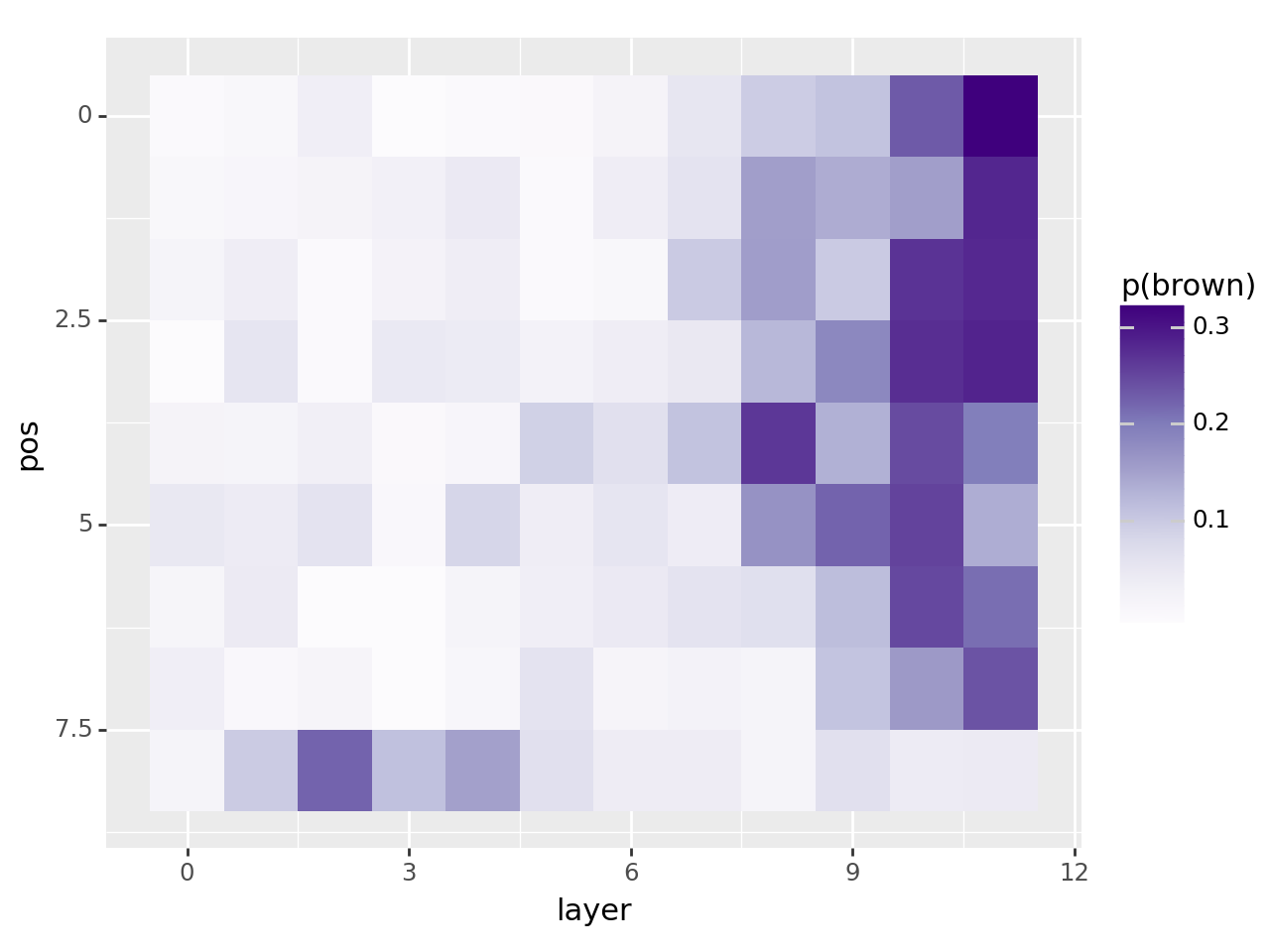Intervening on Vision-Language Models#
This is a quick tutorial for running interventions on the decoder component of BLIP for visual question answering (support for the text/image encoders TBD). This is partially based on an earlier paper I was on, “Towards Vision-Language Mechanistic Interpretability: A Causal Tracing Tool for BLIP” (Palit et al., 2023).
__author__ = "Aryaman Arora"
__version__ = "12/27/2023"
Setup#
try:
# This library is our indicator that the required installs
# need to be done.
import pyvene
except ModuleNotFoundError:
!pip install git+https://github.com/stanfordnlp/pyvene.git
import torch
import pandas as pd
from pyvene import embed_to_distrib, top_vals, format_token
from pyvene import (
IntervenableModel,
VanillaIntervention, Intervention,
RepresentationConfig,
IntervenableConfig,
)
from pyvene import create_blip
from pyvene.models.blip.modelings_blip import BlipWrapper
%config InlineBackend.figure_formats = ['svg']
from plotnine import (
ggplot,
geom_tile,
aes,
facet_wrap,
theme,
element_text,
geom_bar,
geom_hline,
scale_y_log10,
)
from plotnine.scales import scale_y_reverse, scale_fill_cmap
from tqdm import tqdm
from PIL import Image
import requests
from functools import partial
Load model and test inference#
We’ll load BLIPForQuestionAnswering and use a special BlipWrapper to enable easy access of decoder logits; this doesn’t modify the model’s computations in any way.
device = "cuda:0" if torch.cuda.is_available() else "cpu"
config, processor, blip = create_blip(
cache_dir="/nlp/scr/aryaman/.cache/huggingface/hub" # change to your local dir
)
blip = BlipWrapper(blip)
blip.to(device)
loaded model
BlipWrapper(
(model_vis): BlipVisionModel(
(embeddings): BlipVisionEmbeddings(
(patch_embedding): Conv2d(3, 768, kernel_size=(16, 16), stride=(16, 16))
)
(encoder): BlipEncoder(
(layers): ModuleList(
(0-11): 12 x BlipEncoderLayer(
(self_attn): BlipAttention(
(dropout): Dropout(p=0.0, inplace=False)
(qkv): Linear(in_features=768, out_features=2304, bias=True)
(projection): Linear(in_features=768, out_features=768, bias=True)
)
(layer_norm1): LayerNorm((768,), eps=1e-05, elementwise_affine=True)
(mlp): BlipMLP(
(activation_fn): GELUActivation()
(fc1): Linear(in_features=768, out_features=3072, bias=True)
(fc2): Linear(in_features=3072, out_features=768, bias=True)
)
(layer_norm2): LayerNorm((768,), eps=1e-05, elementwise_affine=True)
)
)
)
(post_layernorm): LayerNorm((768,), eps=1e-05, elementwise_affine=True)
)
(model_text_enc): BlipTextModel(
(embeddings): BlipTextEmbeddings(
(word_embeddings): Embedding(30524, 768, padding_idx=0)
(position_embeddings): Embedding(512, 768)
(LayerNorm): LayerNorm((768,), eps=1e-12, elementwise_affine=True)
(dropout): Dropout(p=0.0, inplace=False)
)
(encoder): BlipTextEncoder(
(layer): ModuleList(
(0-11): 12 x BlipTextLayer(
(attention): BlipTextAttention(
(self): BlipTextSelfAttention(
(query): Linear(in_features=768, out_features=768, bias=True)
(key): Linear(in_features=768, out_features=768, bias=True)
(value): Linear(in_features=768, out_features=768, bias=True)
(dropout): Dropout(p=0.0, inplace=False)
)
(output): BlipTextSelfOutput(
(dense): Linear(in_features=768, out_features=768, bias=True)
(LayerNorm): LayerNorm((768,), eps=1e-12, elementwise_affine=True)
(dropout): Dropout(p=0.0, inplace=False)
)
)
(crossattention): BlipTextAttention(
(self): BlipTextSelfAttention(
(query): Linear(in_features=768, out_features=768, bias=True)
(key): Linear(in_features=768, out_features=768, bias=True)
(value): Linear(in_features=768, out_features=768, bias=True)
(dropout): Dropout(p=0.0, inplace=False)
)
(output): BlipTextSelfOutput(
(dense): Linear(in_features=768, out_features=768, bias=True)
(LayerNorm): LayerNorm((768,), eps=1e-12, elementwise_affine=True)
(dropout): Dropout(p=0.0, inplace=False)
)
)
(intermediate): BlipTextIntermediate(
(dense): Linear(in_features=768, out_features=3072, bias=True)
(intermediate_act_fn): GELUActivation()
)
(output): BlipTextOutput(
(dense): Linear(in_features=3072, out_features=768, bias=True)
(LayerNorm): LayerNorm((768,), eps=1e-12, elementwise_affine=True)
(dropout): Dropout(p=0.0, inplace=False)
)
)
)
)
)
(model_text_dec): BlipTextLMHeadModel(
(bert): BlipTextModel(
(embeddings): BlipTextEmbeddings(
(word_embeddings): Embedding(30524, 768, padding_idx=0)
(position_embeddings): Embedding(512, 768)
(LayerNorm): LayerNorm((768,), eps=1e-12, elementwise_affine=True)
(dropout): Dropout(p=0.0, inplace=False)
)
(encoder): BlipTextEncoder(
(layer): ModuleList(
(0-11): 12 x BlipTextLayer(
(attention): BlipTextAttention(
(self): BlipTextSelfAttention(
(query): Linear(in_features=768, out_features=768, bias=True)
(key): Linear(in_features=768, out_features=768, bias=True)
(value): Linear(in_features=768, out_features=768, bias=True)
(dropout): Dropout(p=0.0, inplace=False)
)
(output): BlipTextSelfOutput(
(dense): Linear(in_features=768, out_features=768, bias=True)
(LayerNorm): LayerNorm((768,), eps=1e-12, elementwise_affine=True)
(dropout): Dropout(p=0.0, inplace=False)
)
)
(crossattention): BlipTextAttention(
(self): BlipTextSelfAttention(
(query): Linear(in_features=768, out_features=768, bias=True)
(key): Linear(in_features=768, out_features=768, bias=True)
(value): Linear(in_features=768, out_features=768, bias=True)
(dropout): Dropout(p=0.0, inplace=False)
)
(output): BlipTextSelfOutput(
(dense): Linear(in_features=768, out_features=768, bias=True)
(LayerNorm): LayerNorm((768,), eps=1e-12, elementwise_affine=True)
(dropout): Dropout(p=0.0, inplace=False)
)
)
(intermediate): BlipTextIntermediate(
(dense): Linear(in_features=768, out_features=3072, bias=True)
(intermediate_act_fn): GELUActivation()
)
(output): BlipTextOutput(
(dense): Linear(in_features=3072, out_features=768, bias=True)
(LayerNorm): LayerNorm((768,), eps=1e-12, elementwise_affine=True)
(dropout): Dropout(p=0.0, inplace=False)
)
)
)
)
)
(cls): BlipTextOnlyMLMHead(
(predictions): BlipTextLMPredictionHead(
(transform): BlipTextPredictionHeadTransform(
(dense): Linear(in_features=768, out_features=768, bias=True)
(transform_act_fn): GELUActivation()
(LayerNorm): LayerNorm((768,), eps=1e-12, elementwise_affine=True)
)
(decoder): Linear(in_features=768, out_features=30524, bias=True)
)
)
)
)
Now testing some QA on a simple image.
img_url = "http://images.cocodataset.org/train2017/000000458864.jpg"
raw_image = Image.open(requests.get(img_url, stream=True).raw).convert("RGB")
raw_image

def top_vals(tokenizer, res, n=10):
"""Pretty print the top n values of a distribution over the vocabulary"""
probs = res.softmax(-1)
top_values, top_indices = torch.topk(res, n)
for i in range(len(top_values)):
tok = format_token(tokenizer, top_indices[i].item())
print(
f"{tok:<20} {top_indices[i]:>10} {top_values[i]:>10.5f} {probs[top_indices[i]]:>10.2%}"
)
question = "what is the color of the shirt"
print(question, "\n----")
inputs = processor(raw_image, question, return_tensors="pt").to(device)
print(inputs["input_ids"].shape)
out = blip(**inputs)
print(out["decoder_logits"].shape)
top_vals(processor, out["decoder_logits"][0, 0])
question = "what is the color of the animal"
print(question, "\n----")
inputs = processor(raw_image, question, return_tensors="pt").to(device)
print(inputs["input_ids"].shape)
out = blip(**inputs)
print(out["decoder_logits"].shape)
top_vals(processor, out["decoder_logits"][0, 0])
what is the color of the shirt
----
torch.Size([1, 9])
torch.Size([1, 1, 30524])
red 2417 10.64493 61.74%
white 2317 9.11390 13.35%
pink 5061 8.10488 4.87%
green 2665 7.13710 1.85%
blue 2630 6.71536 1.21%
gray 3897 6.63115 1.12%
black 2304 6.52738 1.01%
brown 2829 6.42861 0.91%
maroon 22222 6.03666 0.62%
multi 4800 5.35350 0.31%
what is the color of the animal
----
torch.Size([1, 9])
torch.Size([1, 1, 30524])
brown 2829 11.42929 88.94%
red 2417 6.36936 0.56%
reddish 14182 5.54194 0.25%
dark 2601 5.49398 0.24%
tan 9092 5.24055 0.18%
light 2422 5.15968 0.17%
brownish 19437 4.64057 0.10%
orange 4589 4.52101 0.09%
rust 18399 4.26794 0.07%
it 2009 4.12371 0.06%
Vanilla intervention#
Let’s see at what transformer blocks and position we can swap activations in order to make the model tell the colour of the shirt instead of the animal.
def simple_position_config(model_type, intervention_type, layer):
config = IntervenableConfig(
model_type=model_type,
representations=[
RepresentationConfig(
layer, # layer
intervention_type, # intervention type
"pos", # intervention unit
1, # max number of unit
),
],
intervention_types=VanillaIntervention,
)
return config
base = processor(raw_image, "what is the color of the animal", return_tensors="pt").to(
device
)
sources = [
processor(raw_image, "what is the color of the shirt", return_tensors="pt").to(
device
)
]
data = []
with torch.inference_mode():
for layer_i in tqdm(range(12)):
for pos_i in range(9):
config = simple_position_config(
type(blip), "block_output", layer_i
)
intervenable = IntervenableModel(config, blip)
_, counterfactual_outputs = intervenable(
base, sources, {"sources->base": ([[[pos_i]]], [[[pos_i]]])}
)
logits = counterfactual_outputs["decoder_logits"][0, 0]
# top_vals(processor, logits, n=1)
logits = logits.softmax(-1)
p_brown = logits[2829]
p_red = logits[2417]
data.append(
{
"layer": layer_i,
"pos": pos_i,
"p(brown)": p_brown.item(),
"p(red)": p_red.item(),
}
)
100%|██████████████████████████████████████████████████████████████████████████████████████████████████████████████████| 12/12 [00:15<00:00, 1.32s/it]
df = pd.DataFrame(data)
df["layer"] = df["layer"].astype(int)
df["pos"] = df["pos"].astype(int)
df["p(brown)"] = df["p(brown)"].astype(float)
df["p(red)"] = df["p(red)"].astype(float)
plot = (
ggplot(df, aes(x="layer", y="pos"))
+ scale_y_reverse()
+ geom_tile(aes(fill="p(red)"))
+ scale_fill_cmap("Purples")
)
print(plot)
Causal tracing#
This replicates the Gaussian interventions from “Locating and Editing Factual Associations in GPT” (Meng et al., 2023) that were also used on BLIP in the paper I linked at the start, i.e. this is a full port into pyvene of the original code for causal tracing on BLIP.
class NoiseIntervention(Intervention):
def __init__(self, embed_dim, **kwargs):
super().__init__()
self.interchange_dim = None
self.embed_dim = embed_dim
self.noise_level = 1.0
def set_interchange_dim(self, interchange_dim):
self.interchange_dim = interchange_dim
def set_noise_level(self, noise_level):
self.noise_level = noise_level
def forward(self, base, source):
# sample gaussian noise
mean = torch.zeros_like(base[..., : self.interchange_dim])
stdev = torch.ones_like(base[..., : self.interchange_dim]) * self.noise_level
noise = torch.normal(mean, stdev)
# interchange
base[..., : self.interchange_dim] += noise
return base
def __str__(self):
return f"NoiseIntervention(embed_dim={self.embed_dim})"
def make_noise_intervention(noise_level):
def func(args, proj_dim, subspace_partition):
intervention = NoiseIntervention(args)
intervention.set_noise_level(noise_level)
return intervention
return func
def corrupted_config(model_type, noise_level):
config = IntervenableConfig(
model_type=model_type,
representations=[
RepresentationConfig(
0, # layer
"block_input", # intervention type
"pos", # intervention unit
1, # max number of unit
),
],
intervention_types=make_noise_intervention(noise_level),
)
return config
def restore_corrupted_config(model_type, layer, noise_level):
config = IntervenableConfig(
model_type=model_type,
representations=[
RepresentationConfig(
0, # layer
"block_input", # intervention type
"pos", # intervention unit
1, # max number of unit
),
RepresentationConfig(
layer, # layer
"block_output", # intervention type
"pos", # intervention unit
1, # max number of unit
),
],
intervention_types=[
make_noise_intervention(noise_level),
VanillaIntervention,
],
# mode='serial'
)
return config
Varying levels of noise#
base = inputs
data = []
with torch.inference_mode():
for noise_level in [0.1, 0.5, 1.0, 2.0, 5.0, 10.0, 20.0]:
for layer_i in tqdm(range(12)):
for pos_i in range(9):
config = restore_corrupted_config(
type(blip), layer_i, noise_level=noise_level
)
intervenable = IntervenableModel(config, blip)
_, counterfactual_outputs = intervenable(
base,
[base, base],
{
"sources->base": (
[
[[0, 1, 2, 3, 4, 5, 6, 7, 8]],
[
[
pos_i,
pos_i,
pos_i,
pos_i,
pos_i,
pos_i,
pos_i,
pos_i,
pos_i,
]
],
],
[
[[0, 1, 2, 3, 4, 5, 6, 7, 8]],
[
[
pos_i,
pos_i,
pos_i,
pos_i,
pos_i,
pos_i,
pos_i,
pos_i,
pos_i,
]
],
],
)
},
)
logits = counterfactual_outputs["decoder_logits"][0, 0].softmax(-1)
p_brown = logits[2829]
data.append(
{
"layer": layer_i,
"pos": pos_i,
"p(brown)": p_brown.item(),
"noise_level": noise_level,
}
)
df = pd.DataFrame(data)
avg_p = df[df["noise_level"] == noise_level]["p(brown)"].mean()
print(f"average prob: {avg_p:.2%}")
100%|██████████████████████████████████████████████████████████████████████████████████████████████████████████████████| 12/12 [00:21<00:00, 1.78s/it]
average prob: 88.95%
100%|██████████████████████████████████████████████████████████████████████████████████████████████████████████████████| 12/12 [00:21<00:00, 1.78s/it]
average prob: 59.44%
100%|██████████████████████████████████████████████████████████████████████████████████████████████████████████████████| 12/12 [00:21<00:00, 1.79s/it]
average prob: 11.18%
100%|██████████████████████████████████████████████████████████████████████████████████████████████████████████████████| 12/12 [00:21<00:00, 1.79s/it]
average prob: 5.78%
100%|██████████████████████████████████████████████████████████████████████████████████████████████████████████████████| 12/12 [00:21<00:00, 1.78s/it]
average prob: 4.00%
100%|██████████████████████████████████████████████████████████████████████████████████████████████████████████████████| 12/12 [00:21<00:00, 1.79s/it]
average prob: 5.99%
100%|██████████████████████████████████████████████████████████████████████████████████████████████████████████████████| 12/12 [00:21<00:00, 1.78s/it]
average prob: 4.40%
df = pd.DataFrame(data)
df["layer"] = df["layer"].astype(int)
df["pos"] = df["pos"].astype(int)
df["p(brown)"] = df["p(brown)"].astype(float)
plot = (
ggplot(df, aes(x="layer", y="pos"))
+ scale_y_reverse()
+ geom_tile(aes(fill="p(brown)"))
+ scale_fill_cmap("Purples")
+ facet_wrap("noise_level")
)
print(plot)
Sampling noise and running repeatedly#
base = inputs
data = []
with torch.inference_mode():
for i in range(10):
for layer_i in tqdm(range(12)):
for pos_i in range(9):
config = restore_corrupted_config(
type(blip), layer_i, noise_level=1.0
)
intervenable = IntervenableModel(config, blip)
_, counterfactual_outputs = intervenable(
base,
[base, base],
{
"sources->base": (
[
[[0, 1, 2, 3, 4, 5, 6, 7, 8]],
[
[
pos_i,
pos_i,
pos_i,
pos_i,
pos_i,
pos_i,
pos_i,
pos_i,
pos_i,
]
],
],
[
[[0, 1, 2, 3, 4, 5, 6, 7, 8]],
[
[
pos_i,
pos_i,
pos_i,
pos_i,
pos_i,
pos_i,
pos_i,
pos_i,
pos_i,
]
],
],
)
},
)
logits = counterfactual_outputs["decoder_logits"][0, 0].softmax(-1)
p_brown = logits[2829]
data.append(
{
"layer": layer_i,
"pos": pos_i,
"p(brown)": p_brown.item(),
"iteration": i,
}
)
df = pd.DataFrame(data)
avg_p = df[df["iteration"] == i]["p(brown)"].mean()
print(f"average prob so far: {avg_p:.2%}")
100%|██████████████████████████████████████████████████████████████████████████████████████████████████████████████████| 12/12 [00:21<00:00, 1.78s/it]
average prob so far: 9.13%
100%|██████████████████████████████████████████████████████████████████████████████████████████████████████████████████| 12/12 [00:21<00:00, 1.78s/it]
average prob so far: 7.91%
100%|██████████████████████████████████████████████████████████████████████████████████████████████████████████████████| 12/12 [00:21<00:00, 1.78s/it]
average prob so far: 7.51%
100%|██████████████████████████████████████████████████████████████████████████████████████████████████████████████████| 12/12 [00:21<00:00, 1.78s/it]
average prob so far: 8.36%
100%|██████████████████████████████████████████████████████████████████████████████████████████████████████████████████| 12/12 [00:21<00:00, 1.79s/it]
average prob so far: 9.84%
100%|██████████████████████████████████████████████████████████████████████████████████████████████████████████████████| 12/12 [00:21<00:00, 1.78s/it]
average prob so far: 8.33%
100%|██████████████████████████████████████████████████████████████████████████████████████████████████████████████████| 12/12 [00:21<00:00, 1.78s/it]
average prob so far: 8.20%
100%|██████████████████████████████████████████████████████████████████████████████████████████████████████████████████| 12/12 [00:21<00:00, 1.78s/it]
average prob so far: 7.92%
100%|██████████████████████████████████████████████████████████████████████████████████████████████████████████████████| 12/12 [00:21<00:00, 1.78s/it]
average prob so far: 8.24%
100%|██████████████████████████████████████████████████████████████████████████████████████████████████████████████████| 12/12 [00:21<00:00, 1.78s/it]
average prob so far: 8.59%
df = pd.DataFrame(data)
df["layer"] = df["layer"].astype(int)
df["pos"] = df["pos"].astype(int)
df["p(brown)"] = df["p(brown)"].astype(float)
plot = (
ggplot(df, aes(x="layer", y="pos"))
+ scale_y_reverse()
+ geom_tile(aes(fill="p(brown)"))
+ scale_fill_cmap("Purples")
+ facet_wrap("iteration")
)
print(plot)
df = pd.DataFrame(data)
df["layer"] = df["layer"].astype(int)
df["pos"] = df["pos"].astype(int)
df["p(brown)"] = df["p(brown)"].astype(float)
df = df.groupby(["layer", "pos"]).mean().reset_index()
print(df)
plot = (
ggplot(df, aes(x="layer", y="pos"))
+ scale_y_reverse()
+ geom_tile(aes(fill="p(brown)"))
+ scale_fill_cmap("Purples")
)
print(plot)



